
The Araceae are a family of monocotyledonous flowering plants in which flowers are borne on a type of inflorescence called a spadix. The spadix is usually accompanied by, and sometimes partially enclosed in, a spathe. Also known as the arum family, members are often colloquially known as aroids. This family of 114 genera and about 3,750 known species is most diverse in the New World tropics, although also distributed in the Old World tropics and northern temperate regions.

Arum maculatum, commonly known as cuckoopint, jack-in-the-pulpit and other names, is a woodland flowering plant species in the family Araceae. It is native across most of Europe, as well as Eastern Turkey and the Caucasus.

Arum is a genus of flowering plants in the family Araceae, native to Europe, northern Africa, and western and central Asia, with the highest species diversity in the Mediterranean region. Frequently called arum lilies, they are not closely related to the true lilies Lilium. Plants in closely related Zantedeschia are also called "arum lilies".
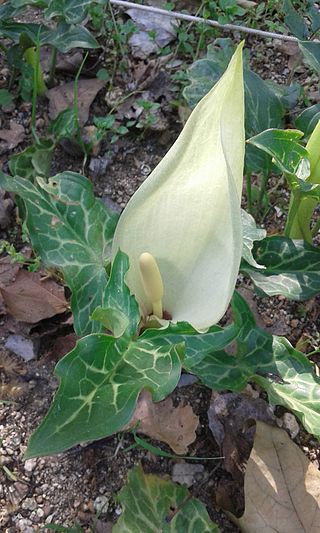
Arum italicum is a species of flowering herbaceous perennial plant in the family Araceae, also known as Italian arum and Italian lords-and-ladies. It is native to the British Isles and much of the Mediterranean region, the Caucasus, Canary Islands, Madeira and northern Africa. It is also naturalized in Belgium, the Netherlands, Austria, Argentina, North Island New Zealand and scattered locations in North America.

Biarum is a genus of flowering plants in the family Araceae. It is composed of plants that are native to the Middle East, southern Europe, and North Africa. Biarum are often found growing in rock crevices and graveled soil composed largely of limestone.

Pothoidium is a monotypic genus of flowering plants in the family Araceae. The single species that comprises the genus is Pothoidium lobbianum. It is native to Maluku, Sulawesi, the Philippines, and Lan Yü Island of Taiwan.
Podolasia is a monotypic genus of flowering plants in the family Araceae. The single known species in the genus is Podolasia stipitata. It is native to Borneo, Sumatra, and Peninsular Malaysia.

Arum dioscoridis, commonly known as the Spotted arum, is a plant of the arum family (Araceae).
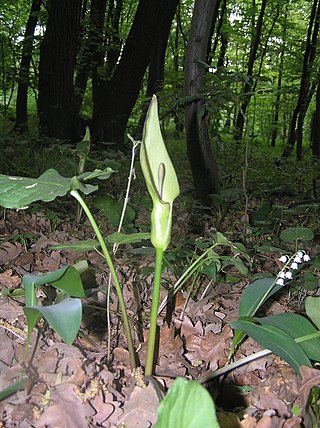
Arum cylindraceum is a woodland plant species of the family Araceae. It is found in most of Europe except the UK, Russia, Ukraine, Belarus, the Baltic States and Scandinavia, and in Turkey. It is also missing in northwestern France and southern Italy.

Arum orientale is a woodland plant species of the family Araceae. It is found in southeastern Europe as far west as Vienna and in Turkey. Its primary range is Romania, Bulgaria, and southern Ukraine.
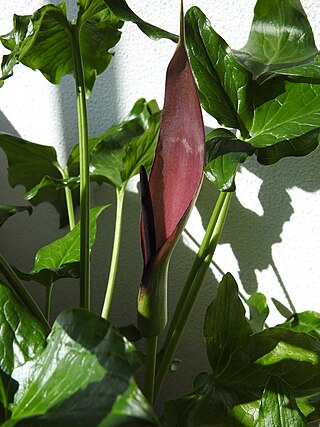
Arum sintenisii, known as Sintenis arum, is a flowering plant species in the family Araceae.
Arum italicum subsp. albispathum is a flowering plant subspecies in the family Araceae.
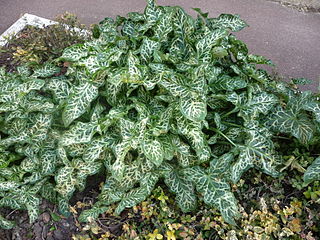
Arum italicum subsp. italicum is a flowering plant subspecies in the family Araceae.
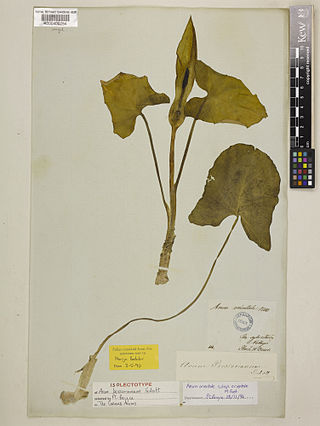
Arum besserianum is a flowering plant species in the family Araceae.

Arum concinnatum, commonly known as the Crete arum, is a flowering plant species in the family Araceae.

Biarum tenuifolium is a tuberous flowering plant species in the family Araceae.
Arum byzantinum is a species of flowering plant in the family Araceae. It was described in 1836.

Arum pictum is a plant of the arum family (Araceae), notable for being the only autumn-flowering plant of its genus.

Anthurium obtusum is a species of plant in the genus Anthurium widely distributed in Central and South America, from Belize to Bolivia. The species was originally described as Anthurium trinerve by Adolf Engler and then in 1997, reclassified. The species is easily confused with Anthurium scandens, but can be distinguished by its terrestrial growth habit and a white spathe which stays erect rather than reflexed.














